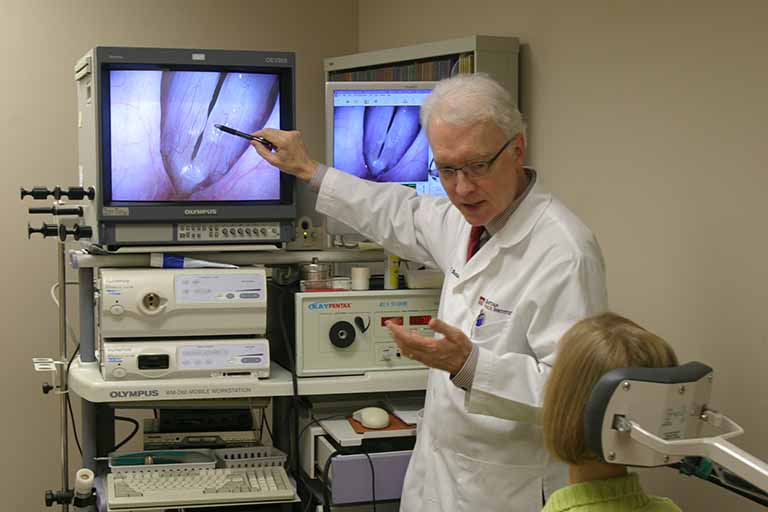Multimedia Encyclopedia
Articles, photo galleries, and videos ranging from A—Z for topics concerning laryngology.
Search Alphabetically
You're viewing encyclopedia entries for the selected letter. You can click a different letter below to browse other entries.
- Abdominal Distention (Crisis) of R-CPD Including Before and After Botox Injection
- Abductor Spasmodic Dysphonia (AB-SD)
- Absent Swallow Reflex
- Achalasia
- Acid Reflux
- Acoustic Analysis of the Voice
- Addition of Loudness
- Adductor Spasmodic Dysphonia (AD-SD)
- Aerodynamic Analysis of Voice
- Air-Wasting Dysphonia
- Amyloid
- Amyloidosis
- Ankylosis
- Antegrade Cricopharyngeal Dysfunction (A-CPD)
- Anterior
- Anterior Commissure
- Anterior Commissure Microweb
- Aryepiglottic Cord
- Arytenoid Cartilages
- Arytenoid Chondritis / Perichondritis
- Aspiration
- Aspiration Pneumonia
- Asymmetrical Vocal Cord Movement
- Atypical Spasmodic Dysphonia
- Auditory Perceptual Evaluation of Voice
- Auto-Immune Laryngitis
- Average/Anchor Frequency
- Can’t Burp? Comprehensive Resources for R-CPD (in One Place)
- Cancer
- Candida Albicans
- Candida Laryngitis and Pharyngitis
- Capillary Ectasia
- Carcinoma
- Carcinoma In Situ (CIS)
- Cartilaginous Glottis
- Ceiling Effect
- Cervical Osteophyte
- Chin Tuck Maneuver
- Choking
- Chondroma of the Larynx
- Cidofovir
- Classic Variant Spasmodic Dysphonia
- Combined Modality Treatment
- Commensal
- Complete Voice Rest
- Composite Food
- Conservation Surgery
- Contact Granuloma
- Cough
- CPAP (Continuous Positive Airway Pressure)
- Creaky Voice
- Cricopharyngeal Myotomy (CPM)
- Cricopharyngeal Spasm (CPS)
- Cricopharyngeus Muscle (Upper Esophageal Sphincter, UES)
- Cricopharyngeus Spasm and What to Do About It
- Croup
- Cryptococcus Neoformans
- Cymetra™
- Gastroesophageal Reflux Disease (GERD)
- Gastrostomy (G) Tube
- General Anesthesia
- General Information about Prescriptions and Medication Information
- Glottic Furrow
- Glottic Stenosis or Scarring
- Glottic Sulcus
- Glottic Web
- Glottis
- Granulation Tissue
- Granulomatosis with Polyangiitis (GPA, Wegener’s Granulomatosis)
- Gross Aspiration
- IA-Only Paresis
- Idiopathic
- Idiopathic Subglottic Stenosis (Inflammatory Stenosis)
- Inability to Burp or Belch
- Inability to Initiate Swallow
- Indicator Lesions
- Indirect vs. Direct Laryngoscopy
- Indole-3-carbinol
- Inferior
- Injection Laryngoplasty
- Inpatient Surgery
- Inspiration
- Inspiratory Phonation
- Integrative Diagnostic Model (IDM)
- Interferon (or Alpha-interferon)
- Intermittent Whisper Phonation
- Intubation Injury
- Involuntary Inspiratory Phonation
- La belle indifference
- Laryngeal Closure or Diversion for Aspiration
- Laryngeal Dystonia
- Laryngeal Electromyogram (LEMG)
- Laryngeal Examination
- Laryngeal Hydration: Taking Care of Your Voice
- Laryngeal Image Biofeedback (LIB)
- Laryngeal mirror examination
- Laryngeal Penetration
- Laryngeal Ventricle
- Laryngeal Vestibule
- Laryngeal Videostroboscopy
- Laryngitis
- Laryngitis & Sore Throats from Acid Reflux
- Laryngitis Sicca
- Laryngocele
- Laryngologist
- Laryngomalacia
- Laryngopharynx
- Laryngopharynx Acid Reflux Disease (LPRD)
- Laryngoscopy
- Laryngospasm
- Larynx
- Larynx Lipoma
- Laser
- Laser Surgery
- Latency
- Lateral
- Laughing
- LCA-Only Paresis
- Leukoplakia
- Lidocaine
- Local Anesthesia
- Long Haul Covid-19 Breathing Tube Injuries Affecting Voice and Breathing
- Lower Esophageal Sphincter (LES)
- Lowered Vocal Ceiling
- Luffing
- Macrophenomenology of Voice
- Marfan Syndrome
- Maximum phonation time (MPT)
- Medial
- Medialization Laryngoplasty
- Membranous Glottis (Musculomembranous Glottis)
- Mitomycin C
- Mixed AB-AD Spasmodic Dysphonia
- Modeling (during vocal capability battery)
- Motivated Laryngeal Examination
- Mucosa
- Mucosal Bridge
- Mucosal Chatter
- Mucosal Edema or Swelling
- Mucus Retention Cyst
- Multi-modality Treatment
- Muscular Tension Dysphonia (MTD)
- Mycobacterium Abscessus: An Infection of the Larynx
- Pachyderma
- Palate
- Palate Deviation
- Palate Elevation
- Palate Paralysis
- Paralyzed Vocal Cords
- Parkinson’s Disease-Related Voice Change
- PCA-only Paresis
- Pedunculated
- Pemphigoid
- Perimenopausal Voice Change
- Pharyngeal Deviation
- Pharyngeal Paralysis
- Pharyngocele
- Pharyngocutaneous Fistula
- Pharynx Contraction
- Phases of Swallowing
- Phonation
- Phonatory Arrest
- Phonatory Gap
- Phonatory Insufficiency
- Pill Dysphagia
- Pitch
- Polypoid Degeneration (aka Reinke’s Edema, Smoker’s Polyps)
- Pontocaine
- Pooling
- Popping Onset
- Positive and Negative Practice
- Post-Radiation Telangiectasia
- Post-surgical Laryngitis
- Post-swallow Hypopharyngeal Reflux
- Posterior
- Posterior Commissure
- Posterior Commissuroplasty
- Posterior Pharyngeal Wall
- Postoperative Voice Use
- Presbylarynx (Presbyphonia)
- Presbyphagia
- Primary Treatment
- Projected Voice
- Pseudo-asthma
- Puberphonia (Mutational Falsetto)
- Pulmonary Function Tests (PFTs)
- Pulse Register
- Pyriform Sinus
- R-CPD Esophageal Findings
- Radiation Mucositis
- Recurrent Laryngeal Nerve
- Recurrent Respiratory Papillomatosis (RRP) and Other HPV-Induced Lesions
- Reductionistic Diagnostic Model
- Redundant Supraglottic Mucosa
- Relative Voice Rest
- Respiratory Dystonia
- Retrograde Cricopharyngeus Dysfunction (R-CPD)
- RevoLix laser
- Rheumatoid Nodules (“Bamboo Nodes”)
- Saccular Cyst
- Sarcoma
- Scarring
- Secondary Gain
- Sedation
- Segmental Vibration
- Sensory Neuropathic Cough (SNC)
- Sessile
- Shattered Vibration
- Shimmer
- Silastic
- Silent Aspiration
- Singing Voice Qualified
- Single Modality Treatment
- Siren
- SLAD-R
- Spasmodic Dysphonia (SD): Definition and Treatments
- Speech Pathologist
- Spindle Cell Carcinoma (Carcinosarcoma, Sarcomatoid Squamous Cell Cancer)
- Spirometry
- Squeezedown (of the voice)
- Stenosis
- Straight tone
- Stridor
- Stripping of Vocal Cords
- Stroboscopy
- Subglottic Stenosis
- Subglottis
- Submucosal Fibrosis
- Superior
- Superior Laryngeal Nerve (SLN) Paralysis
- Supportive Treatment
- Supraglottic Cyst
- Supraglottic Laryngectomy
- Supraglottic Phonation
- Supraglottic Swallow
- Supraglottic Web
- Supraglottis
- Surgical results: before and after photos
- Sustained Phonation
- Swallowing Evaluation and Treatment
- Swallowing Phenomenology
- Swallowing Therapy
- Swelling Checks
- Symptom Complex
- TA + LCA Paresis
- TA-only Paresis
- Talkativeness Scale
- Technology-driven diagnostic model
- Teflon
- Thin Liquids
- Thyrohyoid Syndrome
- Tongue Base Strengthening Exercises
- Tonic Variant Spasmodic Dysphonia
- Tonsils
- Topical Anesthesia
- Torus Mandibularis
- Total Laryngectomy
- Trace Aspiration
- Trachea
- Tracheal Resection and Reanastomosis
- Tracheoesophageal Party Wall
- Tracheoesophageal Voice Prosthesis (TEP)
- Tracheomalacia
- Tracheotomy (Tracheostomy)
- Tracheotomy Dependence
- Tracheotomy Tube
- Traditional diagnostic model (for voice disorders)
- Translucent Polyp
- Transnasal esophagoscopy (TNE)
- Transtracheal Oxygen Therapy (TTO2)
- Transverse Cordotomy
- Treatment for Sensory Neuropathic Cough
- Trial Therapy
- Vallecula
- Vallecular Cyst
- Valsalva Maneuver
- Verrucous Carcinoma
- Vibrato
- Videoendoscopic Swallowing Study (VESS)
- Videoendoscopy
- Videofluoroscopic Swallowing Study (VFSS), (Modified Barium Swallow)
- Viral Laryngitis
- Vocal Aberration
- Vocal Capabilities
- Vocal capability battery
- Vocal Commitments
- Vocal Cord Bowing
- Vocal Cord Bruising
- Vocal cord dysfunction (VCD)
- Vocal Cord Microsurgery (Microlaryngoscopy)
- Vocal Cord Paralysis, Bilateral
- Vocal Cord Paralysis, Unilateral
- Vocal Cord Paresis
- Vocal Cord Scissoring
- Vocal Cord Synechia
- Vocal Cords
- Vocal fry
- Vocal Fry Dysphonia
- Vocal hygiene
- Vocal Instability
- Vocal limitations
- Vocal Loudness Scale
- Vocal Microphenomenology
- Vocal Nodules
- Vocal Overdoer Syndrome
- Vocal Phenomenology
- Vocal Polyp
- Vocal Process
- Vocal self-rapport
- Vocal task
- Vocal Tremor
- Vocal Underdoer Syndrome
- Vocal “Vincibility” Syndrome
- Vocologist
- Voice Building
- Voice evaluation
- Voice Fatigue Syndrome
- Voice production
- Voice Therapy
Search By Disorder
Airway Disorders
These are disorders that affect the upper airway, or manifestations of such disorders:
Involuntary inspiratory phonation
Nonorganic breathing disorder, laryngeal
(aka vocal cord dysfunction)
· Idiopathic subglottic stenosis
· Granulomatosis with Polyangiitis (GPA, Wegener’s Granulomatosis)
·· Forme fruste Wegener’s granulomatosis
Nonorganic breathing disorder, tracheal
(aka nonorganic “asthma” or pseudo-asthma)
Swallowing Disorders
These are disorders in which a person’s swallowing ability or function is affected:
Absent swallow reflex and delayed swallow reflex
Antegrade Cricopharyngeal dysfunction (A-CPD)
· Gross aspiration vs. trace aspiration
Post-swallow hypopharyngeal reflux
Stenosis:
Coughing Disorders

Benign Mucosal Lesions
These are benign lesions or conditions that occur in the larynx but, unlike vocal cord injuries, usually without correlation to voice use:
Contact granuloma (also see granulation tissue)
Keratosis (seen as leukoplakia)
Vocal Cord Vibratory Injuries
Tumors
Benign Tumors
A tumor is considered benign if it doesn’t pose the threat of invading or spreading to other tissues:
Recurrent respiratory papillomatosis
· Caused by human papillomavirus (HPV)
Malignant Tumors
A tumor is considered malignant if it has the potential to invade or spread to other tissues:
Inflammation / Laryngitis
Laryngitis is a general term for inflammation of the larynx. There are different variants and causes:
· Gastroesophageal reflux disease (GERD)
· Laryngopharynx acid reflux disease (LPRD)
Candida laryngitis and pharyngitis
· Caused by candida albicans, a commensal organism
Voice Disorders
Functional Voice Disorders
Functional voice disorders arise not from abnormality of the mechanism itself but instead from abnormal use of the mechanism, affected by personality or deficit of vocal skill, without discernible secondary gain.
Neurological Voice Disorders
Disorders of the nervous system (neurological) can affect the voice in different ways:
Spasmodic dysphonia, a kind of focal dystonia of the larynx; also, laryngeal dystonia
· Abductor spasmodic dysphonia; also called intermittent whisper phonation
· Adductor spasmodic dysphonia
· Atypical spasmodic dysphonia
· Classic variant spasmodic dysphonia
· Mixed AB-AD spasmodic dysphonia
· Tonic variant spasmodic dysphonia
· SLAD-R
· Vocal cord paralysis, bilateral
· Vocal cord paralysis, unilateral
· Superior laryngeal nerve (SLN) paralysis
Nonorganic Voice Disorder
Nonorganic voice disorders arise not from abnormality of the mechanism itself but instead from abnormal use of the mechanism, most often for conscious or subconscious secondary gain.
Miscellaneous Voice Disorders
These are other disorders that affect the voice or otherwise involve the larynx:
Arytenoid chondritis / perichondritis
Breathy-pressed phonation or dysphonia
Presbylarynx (Presbyphonia)
Search By Diagnostics
Procedures & Tools
These procedures, tools, and materials are used to help diagnose a variety of voice, swallowing, airway, and coughing disorders:
Auditory perceptual evaluation of voice
· Laryngeal electromyogram (LEMG)
· Transnasal esophagoscopy (TNE)
History of the present illness
· Laryngeal mirror examination
·· Indirect versus direct laryngoscopy
·· Stroboscopy
· “Motivated” laryngeal examination
Pulmonary function tests (PFTs)
Videoendoscopic swallowing study (VESS)
Videofluoroscopic swallowing study (VFSS)
Vocal capability battery, aka voice evaluation
· Modeling
·· Siren
Voice Phenomenology
Voice phenomenology refers to the audible features of a person’s voice or a person’s related behavior that might be noticed by an examining clinician, either during the person’s spontaneous voice use, or in response to various voice elicitations, as when conducting the vocal capability battery:
Dystonic tremor of the voice or larynx
Obligatory falsetto (Paralytic falsetto)
Methodologies
These different diagnostic models or methodologies affect which diagnostic procedures and tools are relied upon or, whether explicitly or in practice, viewed as optional:
Reductionistic or technology-driven diagnostic model
Types of Clinicians
These are the primary types of clinicians who focus on diagnosing and treating voice, swallowing, airway, and coughing disorders:

Miscellaneous Terms
These are other terms that pertain to the diagnosis of voice, swallowing, airway, and coughing disorders:
Objective measures of phonatory function
· Formant
· Hertz
· Jitter
· Shimmer
Pedunculated versus sessile
Search By Treatment
Treatment for Voice & Larynx Disorders
Procedures
These are various procedures used (or previously used) to treat disorders of the voice or larynx:
Injection laryngoplasty, aka medialization laryngoplasty
Laryngectomy:
Tools & Materials
These are various tools and materials used (or previously used) to treat disorders of the voice or larynx:
Botulinum toxin, aka Botox™
Interferon (or alpha-interferon)
Tracheo-esophageal voice prosthesis
Treatment for Swallowing Disorders
These are some procedures and tools used to treat swallowing disorders:
Treatment for Airway Disorders
These are different procedures and tools used to treat disorders of the upper airway: